Abstract
This study assessed the effects of Betula dahurica (BD), Betula platyphylla (BP), Larix gmelinii (LG), Quercus mongolica (QM), and a mixed conifer–broadleaf forest composed of LG and QM (LGQM) on the soil physicochemical parameters and community structure of fungi in the Zhongyangzhan Black-billed Capercaillie Nature Reserve. Fungal community structures were characterized via ITS rRNA sequencing. The effects of soil parameters on the community structure of soil fungi were assessed by Pearson correlation analysis and redundancy analysis (RDA). LGQM exhibited lower C/N, available nitrogen (AN), total phosphorus (TP), and available phosphorus (AP) compared with the QM broadleaf forest. The fungal Shannon and Simpson diversity indices were highest in BP, whereas LG exhibited the highest ACE index. The Basidiomycota, Ascomycota, Mortierellomycota, and Mucoromycota fungal phyla were dominant across all vegetation types. Each of the different vegetation types studied herein exhibited a unique fungal community structure. The RDA results indicated that fungal community structures were primarily shaped by the total N, available N, and available P of soil. Our findings thus indicated that forests restored with different species of trees may exhibit variations in soil quality and characteristics despite sharing the same climate. Furthermore, broadleaved and coniferous forests exhibited a unique fungal community diversity and composition.
1. Introduction
Forest overexploitation and other human activities have severely damaged the autochthonous vegetation of temperate regions in China, which has negatively impacted biodiversity and ecological functions [1] (Liu et al., 2019). Vegetation restoration is a crucial strategy to preserve ecological functions [2,3,4] (Peng et al., 2013; Nunezmir et al., 2015; Li et al., 2017), biological diversity [5] (Gallardo et al., 2012), and ecosystem services [6] (Oh and Lee, 2009). Vegetation restoration also enhances several soil properties including bulk density [7] (Zhang et al., 2018) and texture and soil/water conditions [8] (Wu et al., 2016), as well as nitrogen, organic carbon, and phosphorous [9] (Xu et al., 2015). Soil microorganism community structure and dynamics are largely shaped by the feedback between plants and soil [10] (Schweitzer et al., 2008). The soil microflora constitutes an important link between plants and soil processes and therefore contributes greatly to the biotransformation of nutrients in soil [11] (Cheng et al., 2013). In particular, nutrient storage is directly determined by the microbial biomass in soils, and microbial metabolism can also indirectly affect nutrient biotransformation [12,13] (Turner et al., 2019; Fan et al., 2020). Nevertheless, despite the critical contributions of soil microorganisms to the global biogeochemical cycles and the success of ecological restoration efforts [14] (Paul et al., 2010), very few studies have characterized the effects of vegetation and soil properties on the structure of soil microbial communities.
Soil fungi are key contributors to several ecological processes [15] (Yue et al., 2021). In particular, fungal communities are intimately linked to a variety of biotic and abiotic factors, such as nutrients [16] (Ding et al., 2021), elevation [17] (Liu et al., 2018), and plant species [18] (Marta et al., 2021). A growing body of evidence has demonstrated that the structure of fungal communities affects several soil properties including nitrogen availability [19] (Frey et al., 2004), texture [20] (Chaudhary et al., 2018), and pH [21] (Kang et al., 2021). Furthermore, vegetation cover also greatly affects soil physicochemical properties. Therefore, vegetation restoration may modify soil properties, leading to changes in the fungal community, which in turn affects restoration success [22] (Wang, 2011). The replanting of native vegetation was recently linked to drastic effects on soil fungal community composition [23] (Yan et al., 2018). Furthermore, a number of studies have characterized the interactions between soil properties and fungal communities in grasslands [24] (Harrison & Bardgett, 2010). Changes in the fungal community composition and diversity during forest vegetation change are key indicator of variation of ecosystem functions [25] (Deng et al., 2019). Previous studies reported that secondary forest succession can result in remarkably shifts in the fungal communities toward that of the original fungal community in Loess Plateau [26] (Chai et al., 2019) and Lowland Forests [27] (Lin et al., 2021). Our previous study revealed that soil carbon metabolism ability obviously varied with forest types such as broadleaf forests (Betula dahurica), coniferous forests (Larix gmelinii), and conifer broadleaf forest (mixed Larix gmelinii and Betula dahurica) in Heilongjiang Zhongyangzhan Black-billed Capercaillie Nature Reserve [28] (Weng et al., 2021). Unfortunately, the fungal community structure and diversity in response to changes in soil physico-chemistry properties in these forest vegetation types have not been studied.
The Heilongjiang Zhongyangzhan Black-billed Capercaillie Nature Reserve (established in 2013) is located in the Elhuli Mountain region of northern China. The native forest vegetation is dominated by Larix gmelinii as the climax community. However, over-exploitation of this resource over the past 100 years has led to drastic landscape changes. Therefore, most current forests are naturally generated secondary forests with various successional stages, such as broad-leaved conifer forests comprising of Betula dahurica, Betula platyphylla, Larix gmelinii, and Quercus mongolica, which provide an outstanding opportunity to assess the effects of vegetation on soil fungal communities under the same climate conditions.
Here, high-throughput sequencing was conducted to characterize the ITS1 rRNA region of fungi to examine the effects of forest succession on both their structure and diversity. Specifically, we aimed to determine (i) how fungal communities respond to forest succession, and (ii) which soil properties are the main determinants of fungal diversity and community structure along with forest succession.
2. Material and Method
2.1. Site Description
The study was carried out in the mountainous areas of the Heilongjiang Zhongyangzhan Black-billed Capercaillie Nature Reserve (126°00′–126°45′ N, 48°30′–48°50′ E; Figure 1). This reserve, which belongs to the Elhuli Mountain range, covers an area of 46,743 ha. The region exhibits a cold temperate continental monsoon climate, with prolonged and cold winters and short warm wet summers, and wide fluctuations in temperature throughout the day. The mean temperature is −0.4 °C, with a maximum temperature of 37 °C and a minimum temperature of −48 °C. The average annual precipitation is 450–550 mm. The soil is deeper than 25 cm, developed from granite and classified as Borice Luvisols, according to the American Soil Taxonomy. The study site exhibits varied and unique biodiversity and therefore its preservation has garnered both national and worldwide attention. Here, we selected four naturally regenerated secondary forests and a natural climax forest (LG) as a reference. Table 1 summarizes the qualities of the five sampling sites selected herein.
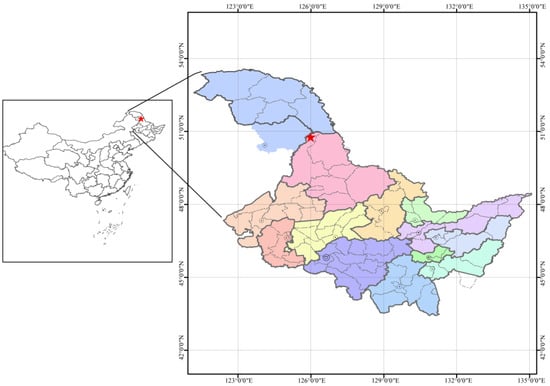
Figure 1.
The asterisk indicates the study site in Heilongjiang Province and China.

Table 1.
Characteristics of the five naturally restored forest types in the Heilongjiang Zhongyangzhan Black-billed Capercaillie Nature Reserve.
2.2. Soil Sampling
Soil samples were acquired in July 2019 from the five selected forest types (Betula dahurica (BD), Betula platyphylla (BP), Larix gmelinii (LG), conifer–broadleaf forest (LGQM), and Quercus mongolica (QM)) (Table 1), and all the five forest types studied were located in the international monitoring site of 25 ha. Within each forest type, three sampling plots (n = 3) were established; dominant tree species, canopy cover, and dominant understory species were considered among the three plots to avoid unrepresentative areas. Within each plot, soil samples (0–20 cm) were collected, using an 8 cm diameter soil auger, from 15–20 locations along an S-shaped path, after removing superficial debris (e.g., leaves and dry vegetation), and mixed to ensure that the soil samples for each plot were representative. The soil samples were then transferred to sterilized press seal bags and stored in an icebox. Next, the samples were taken to the laboratory and immediately sieved (2 mm mesh) to remove stones and plant materials. One portion of the samples was air-dried to conduct physical and chemical analyses, whereas the remainder was kept at −80 °C until required for microbial analysis.
2.3. Characterization of Soil Physicochemical Parameters
A soil–water (1:2.5 w/v) suspension was first shaken for 30 min to measure the soil pH using a pH meter. The total N and organic C of the soil were quantified using an Elemental Analyzer (Elementar, Langenselbold, Germany). Available nitrogen (AN) was sequentially digested in H2SO4-HClO4, 0.5 M NaHCO3, and 2.0 M KCl, and then examined with a continuous flow analysis system (SKALAR SAN++, Breda, the Netherlands). After wet digestion with HClO4–H2SO4, total phosphorus was measured with a spectrophotometer. Available phosphorous (AP) was quantified using a colorimetric method upon extraction with 0.5 M NaHCO3.
2.4. DNA Extraction, PCR Amplification, and MiSeq Sequencing
Using the Fast DNA SPIN Extraction Kit (MP Biomedicals; Santa Ana, CA, USA), genomic DNA was extracted from 0.5 g of soil following the manufacturer’s guidelines. DNA quantity and quality were first detected by agarose gel electrophoresis (1%) and then detected by using a NanoDrop ND-1000 spectrophotometer (Thermo Fisher Scientific; Waltham, MA, USA). The fungal ITS1 region was targeted using the ITS1F (5′-CTT GGT CAT TTA GAG GAA GTA A-3′) and ITS2 (5′-GCT GCG TTC TTC ATC GAT GC-3′) primer set [29] (White et al., 1990). A 7 bp sample-specific DNA barcode was incorporated into the primers for each unique sample to allow for multiplex sequencing. All PCR procedures were conducted in two steps. First, PCR was conducted in triplicate (i.e., three independent 25 µL reactions per DNA sample). Each reaction contained 12.5 µL of 5x PCR mixed reaction buffer, 1 µL (10 µM) of forward and reverse primers, 2 µL of DNA template, and 9.5 µL of ddH2O. The PCR procedure consisted of a 10 min denaturation step at 96 °C followed by 32 cycles at 95 °C for 50 s, 55 °C for 60 s, and 72 °C for 60 s, and finally 72 °C for 10 min. The PCR products were purified using the TAKARA DNA Gel Extraction Kit (TAKARA Biosciences). Afterward, the PCR products were pooled at equal proportions and sequenced conducted by Illumina MiSeq PE300 sequencer.
2.5. Analysis of Sequencing Data
The raw reads were analyzed using QIIME2 [30] (Bolyen et al., 2019) and the UPARSE pipeline. Specifically, UPARSE was used for taxonomical assignment at a >97% similarity threshold [31] (Edgar, 2013). The Unite 8.0 database for fungi was used to carry out taxonomic classification. The raw sequences were deposited to in the SRA database with the accession number PRJNA691096. Operational taxonomic identities were determined using QIIME by executing the BLAST algorithm against sequences in the UNITE 8.0 database [32] (Nilsson et al., 2018). Next, the abundance of each operational taxonomic unit (OTU) per sample and the taxonomy of these OTUs were tabulated. The α-diversity indices (e.g., ACE index, Chao1 index, Simpson index, and Shannon index) were calculated in QIIME2 using the aforementioned OTU table.
2.6. Statistical Analyses
Venn diagrams were generated to visualize the unique and shared OTUs among the samples in R v3.3.2 [33] (R Development Core Team, 2017) using the “Venn Diagram” package. Similarly, heatmaps of the top 50 genera per sample were generated in R using the “ggplot” and “pheatmap” packages [33] (R Development Core Team, 2017). Non-metric multidimensional scaling (NMDS) based on Bray–Curtis matrices was carried out to characterize the composition of the soil fungal community using the “vegan” R package. Linear discriminant analysis (LDA) effect size (LEfSe) analysis was conducted to identify fungal indicator taxa on the basis of a normalized relative abundance matrix across groups using the default parameters. The analysis pipeline was constructed in the Galaxy platform using online interactive tools for the analysis of fungal taxonomy. One-way ANOVA was conducted to identify variations in soil physicochemical parameters, fungal α-diversity, and the relative abundance of different fungal taxa of different forest soils both at the phylum and genus level, after which least significant difference tests were conducted. All analyses were conducted using SPSS version 19.0 (Chicago, IL, USA). Non-metric multidimensional scaling based on Bray–Curtis dissimilarity was conducted in R using the “vegan” package. The correlation between fungal diversity, fungal community structure, and soil characteristics was determined via Pearson correlation analysis. The link between dominant fungal groups and soil characteristics was determined via canonical correspondence analysis in R using the “vegan” package.
3. Results
3.1. Physicochemical Characteristics of Soil
All soil physicochemical parameters measured herein differed significantly among the five forest types (Table 2). Only the soil pH in the BD forest (4.6) was significantly lower than those in other forests (5.3–5.9; p > 0.05) (Table 2). QM soil had the highest SOC, TN, C/N, TP, AN, and AP values, whereas LGQM had the lowest SOC and TN values. LG had the lowest C/N, TP, AN, and AP values (Table 2).

Table 2.
Physicochemical characteristics of the soil samples in the five restored forest types.
Upon conducting principal component analysis (PCA), the PC1 and PC2 represented 32.49% and 24.43% of the total variance (56.92%), respectively. Furthermore, the five forest types assessed herein exhibited a clear separation, as illustrated in the biplot (Figure 2). Taking Axis 1 as a reference, the LG forest vegetation was located in the first quadrant, whereas BP and BD were located in the second and third quadrant, respectively, and LGQM was located in the fourth quadrant (Figure 2). Additionally, there was a clear separation among the different soil parameters examined herein, as demonstrated by their distinct distribution in the PCA biplot (Figure 2). pH was located in the fourth quadrant, whereas all of the remaining parameters were situated in the second and third quadrants (Figure 2).
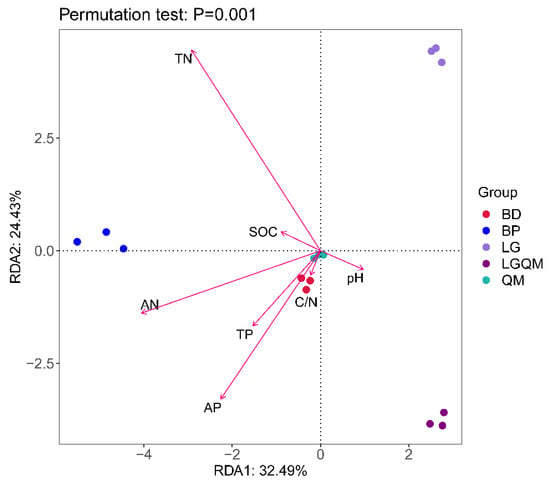
Figure 2.
RDA results, including all of the examined soil physicochemical parameters. BD, Betula dahurica forest; BP, Betula platyphylla forest; LG, Larix gmelinii forest; LGQM, Q. mongolica and L. gmelinii mixed forest; QM, Quercus mongolica forest. TN, total nitrogen; SOC, soil organic carbon; TP, total phosphorous; AN, available nitrogen; AP, available phosphorous.
3.2. Effect of Different Vegetation Types on Fungal Diversity
The α-diversity of the soil fungi exhibited wide variations among the five forest types examined herein (p < 0.05, Table 3). The BP forest soil exhibited the highest OTU number (400), Shannon index (6.30), and Simpson index (0.97), whereas BD soil had the lowest OTU number (278) and QM had the lowest Shannon index (2.84) and Simpson index (0.64) (Table 3). No significant changes in ACE index and Chao1 indices were observed among the BP, LG, LGQM, and QM soils; however, these indices were significantly lower in BD soil (Table 3).

Table 3.
Alpha diversity of the soil fungi in the forest types examined herein.
According to Pearson correlation analysis, the OTU number (r = 0.518, p < 0.05), Simpson index (r = 0.691, p < 0.01), and Shannon index (r = 0.806, p < 0.01) were positively correlated with soil pH, whereas OTU number, Chao1 index, and ACE index were positively related with SOC, C/N, and AP (Table 4). Additionally, OTU number was positively related with TP (r = 0.640, p < 0.01) (Table 4).

Table 4.
Person’s rank correlation coefficients between fungal alpha-diversity and soil parameters.
3.3. Effects of Different Vegetation Types on Fungal Community Structure
Upon filtering out chimeric and low-quality sequences, a total of 1,163,559 high-quality ITS1 sequences were recovered, with an average of 77,570 sequences per soil sample. Among these sequences, a total of 6113 fungal OTUs were identified at the phylum level after quality filtering. Furthermore, averages of 382 OTUs were identified in each sample. The BP forest exhibited the highest OTU number (400), whereas only 278 OTUs were identified in the BD forest (Figure 3). Rarefaction curves, diversity, and richness were obtained by randomly selecting 50,455 reads from each sample. The curve tended to flatten with sequence number at a 3% dissimilarity threshold (Figure 3), thus confirming that the obtained data were highly representative of the forest soil fungal community composition.
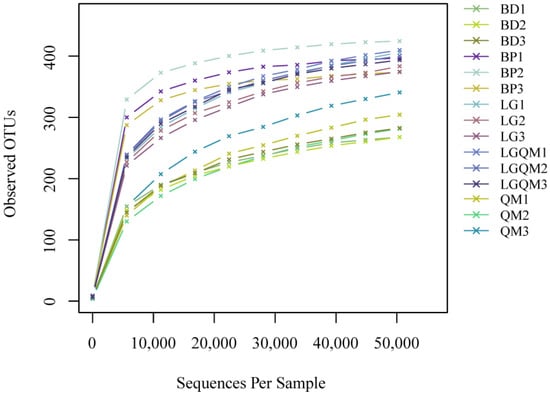
Figure 3.
Rarefaction curves. BD1-BD3, B. dahurica; BP1-BP3, B. platyphylla; LG1-LG3, L. gmelinii; LGQM1-LGQM3, Q. mongolica and L. gmelinii mixed forest; QM1-QM3, Q. mongolica.
All the identified sequences were assigned to seven phyla and one unknown category. Basidiomycota (63.95%), Ascomycota (17.80%), Mortierellomycota (8.55%), and Mucoromycota (7.86%) were the primary phyla in the examined soil samples, accounting for more than 5% of the overall communities (Figure 4). Furthermore, despite being considerably less abundant (<5% of the fungal diversity), Glomeromycota and Chytridiomycota were identified in all of the soil samples. The different forest types had a significant effect on the relative abundances of the most abundant phyla (Figure S1). Basidiomycota, Ascomycota, and Mortierellomycota were significantly changed in five forest vegetation types (p > 0.05, Figure S1). Moreover, Basidiomycota was significantly more abundant in the QM forest soil compared to all other phyla, whereas Ascomycota was the least abundant phylum in the QM forest soil. In contrast, Ascomycota was the most abundant phylum in the LGQM forest soil, but Basidiomycota was least in the LGQM. Mortierellomycota was significantly more abundant in the BP forest, whereas less abundant in the QM forest (Figure 4 and Figure S1).
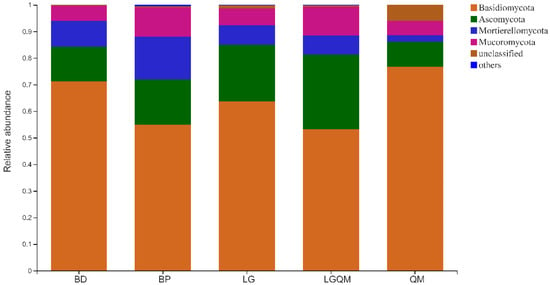
Figure 4.
Effect of revegetation type on the relative abundance of fungal phyla. BD, Betula dahurica; BP, Betula platyphylla; LG, Larix gmelinii; LGQM, Q. mongolica and L. gmelinii mixed forest; QM, Quercus mongolica.
The dominant genera in the soil samples were Tricholoma (13.51%), Russula (13.40%), Cortinarius (9.62%), Inocybe (7.81%), Umbelopsis (5.39%), Cenococcum (2.98%), Boletinus (2.97%), Amanita (2.20%), Mortierella (2.10%), Archaeorhizomyces (1.96%), Clavulina (1.79%), Lactarius (1.22%), and Suillus (1.19%) (Figure S2). According to the one-way ANOVA (Figure S3), the most five abundance genera of Russula, Tricholoma, Cortinarius, and Inocybe changed significantly in five forest vegetation types. Tricholoma was the most abundant genus in the QM forest soil, accounting for 58.77% of the total diversity. In contrast, Russula was most abundant in LGQM soil (Figure S2).
The structures of the fungal communities, particularly the unique and shared OTUs among the samples, were visualized using Venn diagrams. A total of 194 OTUs were shared between all the forest types examined herein (Figure 5). Among the remaining OTUs, 8 were only identified in BD, 39 in BP, 39 in LG, 13 in LGQM, and 1 in QM (Figure 5).
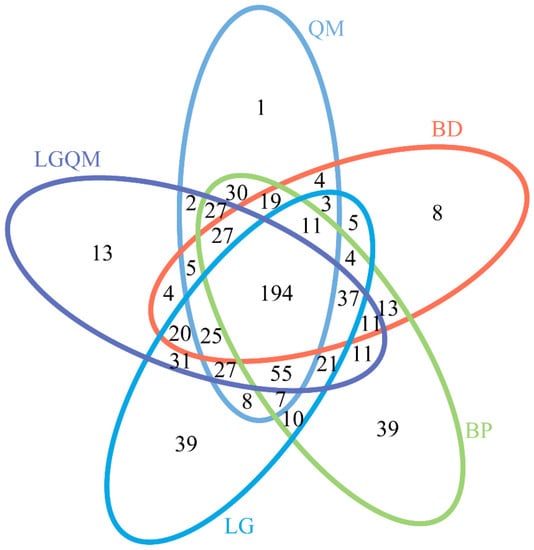
Figure 5.
Venn diagram of shared and unique fungal OTUs among the vegetation types. BD, Betula dahurica; BP, Betula platyphylla; LG, Larix gmelinii; LGQM, Q. mongolica and L. gmelinii mixed forest; QM, Quercus mongolica.
The NMDS analysis results demonstrated that each revegetation type was accompanied by a unique fungal diversity (Figure 6). Heatmap analysis using the 30 most abundant fungal genera indicated that the genera Tricholoma, Clavulina, Cenococcum, and Russula were dominant in the QM forest (Figure 7). Furthermore, the LG forest was dominated by Inocybe, Boletinus, Suillus, Penicillium, Discocistella, Sebacinaceae, Mortierella, Umbelopsis, Cenococcum, and Russula (Figure 7). Inocybe, Lactarius, Clavaria, Mortierella, Umbelopsis, Russula, and Cortinarius were the most dominant genera in the BP forest. The most dominant genera in the BD forest were Inocybe, Archaeorhizomyces, Amanita, Umbelopsis, Russula, and Cortinarius (Figure 7). Archaeorhizomyces, Tricholoma, Inocybe, Russula, and Clavulina were dominant in the LGQM forest (Figure 7).
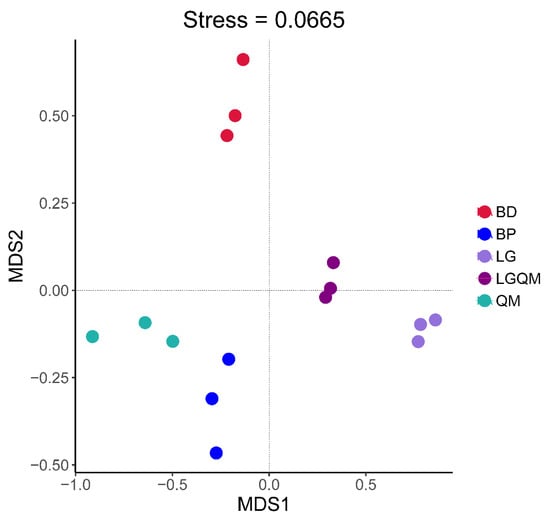
Figure 6.
NMDS analysis of the fungal communities in the different forest type soils. BD, Betula dahurica; BP, Betula platyphylla; LG, Larix gmelinii; LGQM, Q. mongolica and L. gmelinii mixed forest; QM, Quercus mongolica.
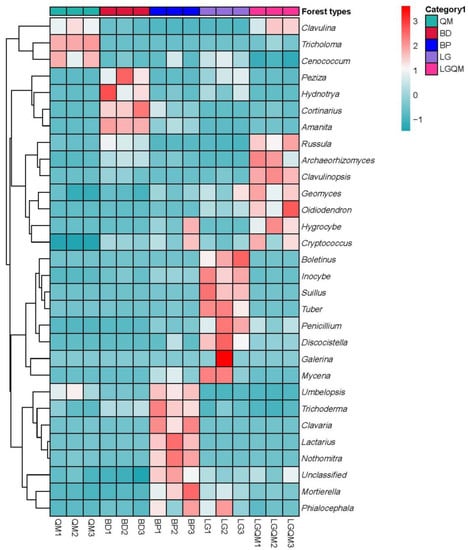
Figure 7.
Heatmap and hierarchical clustering of the relative abundances of the top 30 genera detected in the soil fungal communities. The color gradient (red, white, blue) represents the relative abundance of the soil fungi from high to low in the different forest types. BD1–BD3, Betula dahurica; BP1–BP3, Betula platyphylla; LG1–LG3, Larix gmelinii; LGQM1–LGQM3, Q. mongolica and L. gmelinii mixed forest; QM1–QM3, Quercus mongolica.
3.4. Indicator Species
Significant differences were observed among 22 taxa in the five forest types, as indicated by LDA effect size scores of >4.5 (Figure 8A). Furthermore, 11 taxa exhibited significant differences among the forest types, with LDA > 5.0 (Figure 8B).
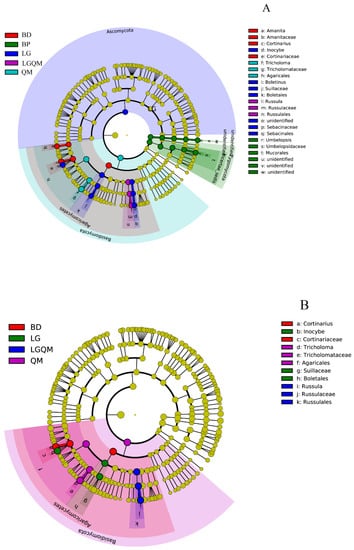
Figure 8.
Cladogram of the fungal communities in the five types of forest soils with LDA > 4.5 (A) and >5.0 (B). The circles represent fungal taxa from phylum to genus starting from the center. BD, Betula dahurica; BP, Betula platyphylla; LG, Larix gmelinii; LGQM, Q. mongolica and L. gmelinii mixed forest; QM, Quercus mongolica.
3.5. Primary Shapers of Fungal Community Structure
The cumulative variations in the first and second RDA axes were 27.20% and 13.18, respectively (Figure 9), which demonstrated that the structure of the fungal communities was substantially influenced by the physicochemical properties of the soil.
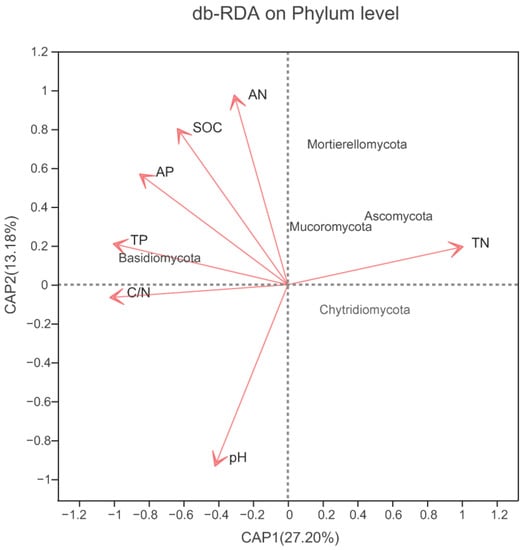
Figure 9.
RDA of the dominant fungal phyla in soil constrained by soil variables.
Table 5 summarizes the five most abundant phyla and the 15 most abundant genera according to different soil physicochemical properties. At the phylum level, our findings indicated that the relative abundance of Ascomycota was negatively correlated with soil AN (r = −0.613, p < 0.05) and AP (r = −0.708, p < 0.01) (Table 5). At the genus level (Table 5), Cortinarius and Amanita abundances were negatively correlated with pH, whereas those of Clavulina and Hygrocybe were positively correlated. Tricholoma, Umbelopsis, and Cenococcum were positively correlated with SOC, whereas Russula, Archaeorhizomyces, and Thelephora were negatively correlated. Umbelopsis and Cenococcum were positively correlated with TN; in contrast, Russula, Archaeorhizomyces, and Hygrocybe were negatively correlated. Tricholoma, Umbelopsis, and Clavulina were positively correlated with C/N, whereas Inocybe was negatively correlated with this parameter. Tricholoma and Umbelopsis were positively correlated with TP, whereas Inocybe, Boletus, and Suillus were negatively correlated. Umbelopsis was positively correlated with AN, while Inocybe, Boletus, and Suillus were negatively correlated. Tricholoma, Umbelopsis, and Clavulina were positively correlated with AP, whereas Inocybe, Boletus, and Suillus were negatively correlated.

Table 5.
Person’s rank correlations between the relative abundances of dominant bacteria taxa and soil physicochemical parameters.
4. Discussion
4.1. Characteristics of Soils in the Naturally Restored Forests
The soil nutrient concentrations varied substantially among the five vegetation types (Table 2). Specifically, the broadleaved forest (QM) exhibited the best soil quality, whereas the coniferous forest (LG) had the poorest soil quality, in agreement with the findings of Vitali et al. [34] (2016). These differences in soil quality were likely due to the litter characteristics and root exudates of Quercus mongolica [35] (Li et al., 2014). In contrast, cold, temperate, deciduous L. gmelinii forests exhibited higher litter amounts with higher concentrations of recalcitrant substances such as resin, lignin, wax, and tannin. Coverage of the forest floor by dense coniferous litter is thought to obstruct air circulation, thus preventing nutrient accumulation. Conversely, Q. mongolica commonly occurs in warm evergreen broadleaf forests and produces litter that is easily decomposed, thus enhancing nutrient quality [11] (Cheng, 2013).
The pH of the soil in the study site ranged from 4.6 to 5.9, among which the lowest pH values were observed in the soil surrounding B. dahurica. These acidic conditions are likely due to litter quality. B. dahurica produces leaf litter with low nitrogen content, higher lignin content, high C/N ratio, and higher lignin/N relative to other types of broadleaf forests [36] (Gao et al., 2015). Similarly, variations in the characteristics of leaf litter produced by different tree species have been linked to differences in soil quality even under equal climate conditions [37] (Ge et al., 2012). These observations aligned with our findings, as the soils studied herein could be classified into five groups on the basis of their physicochemical properties (Figure 2). These differences in soil characteristics, particularly those between broadleaf and coniferous forests, may contribute greatly to shaping the community structure of soil microbes.
4.2. Effects of Vegetation Types on the Diversity and Structure of Fungal Communities
Our findings indicated that different forest vegetation types had unique effects on fungal community diversity and structure (Table 3; Figure 4 and Figure S1). The BP forest exhibited the highest fungal Shannon index (Table 3), which indicated that this forest type possessed the highest soil fungal diversity and evenness. Furthermore, the LG forest exhibited the highest fungal ACE index, indicating a higher fungal abundance in the soil. These findings were ascribed to the variations in the chemical composition and decomposition rate of the litter produced by the aforementioned forest types [38] (Anderson, 2009), which affect the physicochemical properties of soil and, in turn, modify the fungal diversity indices of the soil. Our observations confirmed that the effects of the tree species on fungal diversity were most likely due to the litter quantity and quality produced by the trees following revegetation. Interestingly, the different revegetation types did not affect the overall fungal community composition of the soil but did modify the relative abundances of different taxa. These outcomes were likely attributable to variations in the root residues and secretions produced by different species of trees [39] (Degrune et al., 2015). Despite the small sample sizes of our study (n = 3), we identified significant differences in the structure of the fungal communities associated with the different revegetation types studied herein. The fungal communities were largely dominated by the Basidiomycota phylum, followed by Ascomycota, Mortierellomycota, and Mucoromycota (Figure 4). Importantly, these findings were in line with those of Gorfer et al. [40] (2013) and Waring et al. [41] (2016). Basidiomycota typically inhabit dry and cool habitats [42] (Sui et al., 2021), and their relative abundance in soils is thought to be linked to their capacity to metabolize lignocellulose [43] (Alfaro et al., 2016), which in turn is determined by soil organic carbon dynamics [44] (Blackwood et al., 2010). Moreover, the BP forest exhibited a high relative abundance of Ascomycota, which was consistent with the findings of Gao et al. [45]. Previous studies in tropical regions have also demonstrated that broadleaf forests are largely dominated by the Ascomycota phylum [25]. The high abundance of Ascomycota in BP observed in our study suggested the presence of saprotrophs, which provide Ascomycota with easily degradable nutrient sources such as organic matter [46]. The variations in the fungal abundances in soils with different vegetation may also be due to environmental filtering and niche differentiation [47].
The Tricholoma, Russula, and Cortinarius genera were dominant in the soil samples examined herein (Figure S1), which was consistent with other studies [48,49]. Russula was among the most common genera in our study, and past literature has suggested that some members of this genus might provide water and nutrients to their host plants, thus allowing them to overcome biotic and abiotic stress [50]. The members of the genus Cortinarius are ubiquitous fungi that are distributed worldwide [51]. Interestingly, this genus was also among the most common in our study. The effects of forest types on the diversity and abundance of fungi have been linked to the quantity and characteristics of the organic matter derived from plant litter, as it constitutes an important nutrient source for soil microorganism growth [52]. The heatmap in Figure 6 and the NMDS plots in Figure 7 demonstrate that variations in revegetation type shaped the fungal communities in the surrounding soil. This distinction was particularly noticeable when comparing the fungal community structures associated with broad-leaved and coniferous forests. A recent study also demonstrated that the soil fungal community composition in Pinus koraiensis forests was different from that in a broadleaved Pinus koraiensis mixed forest [25]. Therefore, our findings demonstrated the strong influence of forest and vegetation types on the structure and diversity of soil fungal communities [53].
4.3. Effects of Soil Characteristics on Fungal Communities
Soil properties strongly influence the structure and diversity of fungal communities. Here, OTU number, Shannon index, and Simpson index exhibited a positive correlation with pH (Table 4), which was consistent with the findings of Hartmann et al. [54] and Li et al. [55]. Moreover, OTU number, Chao1 index, and ACE index were positively correlated with available P (Table 4), which largely mirrored the findings of Liu et al. [56]. Other studies have demonstrated that several physicochemical characteristics of soil including moisture [57], pH [58], organic carbon [59], and C/N ratio [60] substantially affect the composition of fungal communities. Our findings also confirmed that the abundances of fungi at the phylum and genus levels were significantly correlated with soil pH. Furthermore, the composition of the fungal communities was significantly correlated with total N, SOC, available N, and available P (Table 5; Figure 9), which was in line with previous findings [7,53].
The members of the Basidiomycota phylum are highly sensitive to variations in soil physicochemical properties [42]. Here, the relative abundance of Basidiomycota was negatively correlated with AP and pH, which contrasted with previous reports [61,62]. Wang et al. [63] reported higher Ascomycota abundances in soils with higher pH values. In contrast, our study did not identify any correlation between Ascomycota abundance and soil pH, which may be due to the relatively narrow soil pH range (4.6–5.9) in our study, which translated to low variations in the abundance of Ascomycota in our study. Furthermore, the relative abundance of both Ascomycota and Mortierellomycota was negatively correlated with available P, suggesting that this parameter plays a crucial role in shaping the fungal community structure, which aligns with the reports of Dang et al. [64]. Furthermore, Wu et al. [65] recently reported that the abundance of Ascomycota was positively correlated with soil organic matter content. Taken together, our findings indicated that the composition and diversity of soil fungal communities are strongly shaped by variations in revegetation types, as different plant species can have unique effects on soil physicochemical properties.
The dominant fungal genera (Russula, Tricholoma, Cortinarius, and Inocybe) were representative of the dominant genera found in our study (Figure S2), which was accordant with previous research (Lin et al., 2021). Russula was the most common genus in our study, and previous studies have put forward that Russula was symbionts of trees and are therefore abundant in forests [54]. The influence of different forest vegetation on the soil fungal community is often related to the quantity of organic matter and nitrogen returned by plant litter, which provides major nutrition for soil fungi [25]. On the basis of previous research, Tricholoma has been reported to be distributed throughout the forests [66], which was also the common genus in our study. Cortinarius and Inocybe were mainly ectomycorrhizal fungi in the forests that can help its host plant to overcome biotic and abiotic stresses by supplying it with water and nutrients [67].
The results of clear differentiation in the NMDS (Figure 6) and heatmap (Figure 7) and Cladogram (Figure 8) plots illustrated that distinct differences in the fungal communities were observed in different forest types, suggesting that broad-leaved forests, coniferous forests, and mixed conifer–broadleaf forests each owned different fungal communities. Our results were agreement with a previous study that investigated the composition of soil fungal community in different forest types in the Korean pine plantation [25]. These findings confirmed that composition of forests with different tree species altered the soil fungal community composition and diversity. Moreover, this proves the conclusion that the different forest vegetation types shape the soil fungal community through affecting the soil physicochemistry properties [26].
This study investigated the fungal structure and diversity of different forest types in Zhongyangzhan Black-billed Capercaillie Nature Reserve. This study provided data support for understanding the changes of soil microorganisms during the succession of high-latitude forest vegetation, and also enriched the impact of forest vegetation changes on the variation of microorganisms in soil. In high-latitude, cold-region forest ecosystems, in the process of forest succession, in addition to being affected by soil physicochemical properties and vegetation types, the litter composition, root biomass, and exudates all affect the composition and composition of soil fungi. Therefore, multi-dimensional comprehensive experiments will be carried out in the future to explain the response mechanism of soil microbial community structure and function to environmental heterogeneity during forest succession.
5. Conclusions
Our findings indicated that the fungal community of the Heilongjiang Zhongyangzhan Black-billed Capercaillie Nature Reserve is largely dominated by the Basidiomycota, Ascomycota, Mortierellomycota, and Mucoromycota phyla, and their relative abundances varied significantly in a revegetation type-dependent manner. Moreover, the different revegetation types significantly affected the OTU number and the ACE, Shannon, Simpson, and Chao1 indices of the fungal communities of the study site. Furthermore, the abundances of the most dominant phyla and genera were significantly correlated with soil pH, SOC, total N, available P, total P, and available N. Collectively, our results demonstrated the effects of vegetation type on soil fungal communities could be attributed to the quantity and qualities of the litter derived from different vegetation types, as this can lead to variations in soil quality even in regions with equal climate conditions. This was particularly noticeable when comparing the fungal community composition and diversity of broad-leaved and coniferous forests.
Supplementary Materials
The following supporting information can be downloaded at https://www.mdpi.com/article/10.3390/microorganisms10040829/s1.
Author Contributions
X.S., X.Z. and M.L. (Mengsha Li) designed and performed the experiment and prepared this manuscript. X.W. helped to finish the bioinformatic analysis. B.F. and M.L. (Maihe Li) revised this manuscript and language editing. L.Y. was in field work to collect the samples. All coauthors contributed to manuscript editing. All authors have read and agreed to the published version of the manuscript.
Funding
This work was funded by the Key Laboratory of Forest Plant Ecology, Ministry of Education of China (K2020A02); the National Natural Sciences Foundation of China (32011530425); the Natural Sciences Foundation of Heilongjiang Province (LH2020C088); the Outstanding Youth Foundation of Heilongjiang University (JCL202006); Heilongjiang Province Postdoctoral Research Project (LBH-Q21167) and the China Scholarship Council Visiting Scholar Program (201908230401).
Institutional Review Board Statement
Not applicable.
Informed Consent Statement
Not applicable.
Data Availability Statement
Raw data of fungal sequences were deposited into the NCBI Sequence Read Archive under acces-sion number PRJNA691096.
Acknowledgments
We are grateful to Zhenzhu Zhao, leader of the Heilongjiang Zhongyangzhan Black-billed Capercaillie Nature Reserve, for allowing us access to the Nature Reserve, as well as to Zhenzhu Zhao, Fuyuan Chen, and Xianda Li for their assistance in sample processing. We also thank Luo Chunyu for preparing the figures.
Conflicts of Interest
The authors declare that the research was conducted in the absence of any commercial or financial relationships that could be construed as a potential conflict of interest.
References
- Liu, J.; Coomes, D.A.; Gibson, L.; Hu, G.; Liu, J.; Luo, Y.; Yu, M. Forest fragmentation in China and its effect on biodiversity. Biol. Rev. 2019, 94, 1636–1657. [Google Scholar] [CrossRef] [PubMed]
- Peng, S.; Chen, A.; Fang, H.; Wu, J.; Liu, G. Effects of vegetation restoration types on soil quality in Yuanmou dry-hot valley, China. Soil Sci. Plant Nutr. 2013, 59, 347–360. [Google Scholar] [CrossRef]
- Nunezmir, G.C.; Iannone, B.V.; Curtis, K.; Fei, S. Evaluating the evolution of forest restoration research in a changing world: A “big literature” review. New Forest 2015, 46, 669–682. [Google Scholar] [CrossRef]
- Li, H.L.; Zhang, J.; Wang, L.; Yang, H.; Yan, H.E.; Lu, L.U. The Influence of Land Use Change on the Microbial Community in Two Acidic Soils. J. Chin. West Norm. Univ. 2017, 38, 373–381. [Google Scholar]
- Gallardo, B.; Cabezas, A.; Gonzalez, E.; Comín, F.A. Effectiveness of a newly created oxbow lake to mitigate habitat loss and increase biodiversity in a regulated floodplain. Restor Ecol. 2012, 20, 387–394. [Google Scholar] [CrossRef]
- Oh, W.S.; Lee, C. Recovery of Ecosystem Service Functions through Ecological Restoration Practice: A Case Study of Coal Mine Spoils, Samcheok, Central Eastern Korea. Environ. Biol. Res. 2014, 32, 102–111. [Google Scholar] [CrossRef]
- Zhang, Q.; Jia, X.; Zhao, C.; Shao, M.A. Revegetation with artificial plants improves topsoil hydrological properties but intensifies deep-soil drying in northern Loess Plateau, China. J. Arid Land 2018, 10, 335–346. [Google Scholar] [CrossRef]
- Wu, G.L.; Liu, Y.; Fang, N.F.; Deng, L.; Shi, Z.H. Soil physical properties response to grassland conversion from cropland on the semi-arid area. Ecohydrology 2016, 9, 1471–1479. [Google Scholar] [CrossRef]
- Xu, M.; Zhang, J.; Liu, G.B.; Zhang, T. Effects of Revegetation Types on the Soil Carbon, Nitrogen and Phosphorus of the Gully Areas in Hilly Loess Plateau, China. Acta Agrectir. Sin. 2015, 23, 62–68. [Google Scholar]
- Schweitzer, J.A.; Bailey, J.K.; Fischer, D.G.; LeRoy, C.J.; Lonsdorf, E.V.; Whitham, T.G.; Hart, S.C. Plant–soil–microorganism interactions: Heritable relationship between plant genotype and associated soil microorganisms. Ecology 2008, 89, 773–781. [Google Scholar] [CrossRef]
- Cheng, F.; Peng, X.; Zhao, P.; Yuan, J.; Zhong, C.; Cheng, Y.; Zhang, S. Soil microbial biomass, basal respiration and enzyme activity of main forest types in the Qinling Mountains. PLoS ONE 2013, 8, e67353. [Google Scholar] [CrossRef] [PubMed]
- Turner, B.L.; Zemunik, G.; Laliberté, E.; Drake, J.J.; Jones, F.A.; Saltonstall, K. Contrasting patterns of plant and microbial diversity during long-term ecosystem development. J. Ecol. 2019, 107, 606–621. [Google Scholar] [CrossRef]
- Fan, M.; Li, J.; Tang, Z.; Shangguan, Z. Soil bacterial community succession during desertification in a desert steppe ecosystem. Land. Degrad. Dev. 2020, 31, 1662–1674. [Google Scholar] [CrossRef]
- Paul, M.; Catterall, C.P.; Pollard, P.C.; Kanowski, J. Recovery of soil properties and functions in different rainforest restoration pathways. For. Ecol. Manag. 2010, 259, 2083–2092. [Google Scholar] [CrossRef]
- Yue, P.; Cui, X.; Zuo, X.; Li, K.; Wang, S.; Jia, Y.; Liu, X. The contribution of arbuscular mycorrhizal fungi to ecosystem respiration and methane flux in an ephemeral plants-dominated desert. Land Degrad. Dev. 2021, 32, 1844–1853. [Google Scholar] [CrossRef]
- Ding, T.; Yan, Z.; Zhang, W.; Duan, T. Green Manure Crops Affected Soil Chemical Properties and Fungal Diversity and Community of Apple Orchard in the Loess Plateau of China. J. Soil Sci. Plant Nutr. 2021, 21, 1089–1102. [Google Scholar] [CrossRef]
- Liu, D.; Liu, G.; Chen, L.; Wang, J.; Zhang, L. Soil pH determines fungal diversity along an elevation gradient in Southwestern China. Sci. China Life Sci. 2018, 61, 718–726. [Google Scholar] [CrossRef]
- Gil-Martínez, M.; López-García, A.; Domínguez, M.T.; Kjøller, R.; Navarro-Fernández, C.M.; Rosendahl, S.; Marañón, T. Soil fungal diversity and functionality are driven by plant species used in phytoremediation. Soil Biol. Biochem. 2021, 153, 108102. [Google Scholar] [CrossRef]
- Frey, S.D.; Knorr, M.; Parrent, J.L.; Simpson, R.T. Chronic nitrogen enrichment affects the structure and function of the soil microbial community in temperate hardwood and pine forests. Forest Ecol. Manag. 2004, 196, 159–171. [Google Scholar] [CrossRef]
- Chaudhary, V.B.; Cuenca, G.; Johnson, N.C. Tropical—Temperate comparison of landscape-scale arbuscular mycorrhizal fungal species distributions. Divers. Distrib. 2018, 24, 116–128. [Google Scholar] [CrossRef]
- Kang, E.; Li, Y.; Zhang, X.; Yan, Z.; Wu, H.; Li, M.; Kang, X. Soil pH and nutrients shape the vertical distribution of microbial communities in an alpine wetland. Sci. Total Environ. 2021, 774, 145780. [Google Scholar] [CrossRef]
- Wang, J.; Shi, X.; Zheng, C.; Suter, H.; Huang, Z. Different responses of soil bacterial and fungal communities to nitrogen deposition in a subtropical forest. Sci. Total Environ. 2021, 755, 142449. [Google Scholar] [CrossRef] [PubMed]
- Yan, D.; Mills, J.G.; Gellie, N.J.; Bissett, A.; Lowe, A.J.; Breed, M.F. High-throughput eDNA monitoring of fungi to track functional recovery in ecological restoration. Biol. Conserv. 2018, 217, 113–120. [Google Scholar] [CrossRef]
- Harrison, K.A.; Bardgett, R.D. Influence of plant species and soil conditions on plant–soil feedback in mixed grassland communities. J. Ecol. 2010, 98, 384–395. [Google Scholar] [CrossRef]
- Deng, J.; Yin, Y.; Luo, J.; Zhu, W.; Zhou, Y. Different revegetation types alter soil physical-chemical characteristics and fungal community in the Baishilazi Nature Reserve. Peer J. 2019, 6, e6251. [Google Scholar] [CrossRef]
- Chai, Y.F.; Cao, Y.; Yue, M.; Tian, T.T.; Yin, Q.L.; Dang, H.; Quan, J.X.; Zhang RCWang, M. Soil abiotic properties and plant functional traits mediate associations between soil microbial and plant communities during a secondary forest succession on the Loess Plateau. Front. Microbiol. 2019, 10, 895. [Google Scholar] [CrossRef]
- Lin, Q.; Baldrian, P.; Li, L.J.; Novotny, V.; Heděnec, P.; Kukla, J.; Umari, R.; Meszárošová, L.; Frouz, J. Dynamics of soil bacterial and fungal communities during the secondary succession following swidden agriculture in lowland forests. Front. Microbiol. 2021, 12, 1421. [Google Scholar] [CrossRef]
- Weng, X.; Li, J.; Sui, X.; Li, M.; Yin, W.; Ma, W.; Yang, L.; Mu, L. Soil Microbial Functional Diversity Responses to Different Revegetation Types in Heilongjiang Zhongyangzhan Black-billed Capercaillie Nature Reserve. Ann. Microbiol. 2021, 71, 26. [Google Scholar] [CrossRef]
- White, T.J.; Bruns, T.; Lee, S.; Taylor, J.W. Amplification and direct sequencing of fungal ribosomal RNA genes for phylogenetics. In PCR Protocols: A Guide to Methods and Applications; Academic Press Inc.: New York, NY, USA, 1990; pp. 315–322. [Google Scholar]
- Bolyen, E.; Rideout, J.R.; Dillon, M.R.; Bokulich, N.A.; Abnet, C.C.; Al-Ghalith, G.A.; Caporaso, J.G. Reproducible, interactive, scalable and extensible microbiome data science using QIIME 2. Nat. Biotechnol. 2019, 37, 852–857. [Google Scholar] [CrossRef]
- Edgar, R.C. UPARSE: Highly accurate OTU sequences from microbial amplicon reads. Nat. Methods 2013, 10, 996–998. [Google Scholar] [CrossRef]
- Nilsson, R.H.; Larsson, K.H.; Taylor, A.F.S.; Bengtsson-Palme, J.; Jeppesen, T.S.; Schigel, D.; Kennedy, P.; Picard, K.; Glöckner, F.O.; Tedersoo, L.; et al. The UNITE database for molecular identification of fungi: Handling dark taxa and parallel taxonomic classifications. Nucleic Acids Res. 2018, 47, 259–264. [Google Scholar] [CrossRef] [PubMed]
- R Development Core Team. R: A Language and Environment for Statistical Computing; R Foundation for Statistical Computing: Vienna, Austria, 2017; Available online: http://www.R-project.org/ (accessed on 10 April 2021).
- Vitali, F.; Mastromei, G.; Senatore, G.; Caroppo, C.; Casalone, E. Long lasting effects of the conversion from natural forest to poplar plantation on soil microbial communities. Microbiol. Res. 2016, 182, 89–98. [Google Scholar] [CrossRef] [PubMed]
- Li, H.; Ye, D.; Wang, X.; Settles, M.L.; Wang, J.; Hao, Z.; Ma, Z.S. Soil bacterial communities of different natural forest types in Northeast China. Plant Soil 2014, 383, 203–216. [Google Scholar] [CrossRef]
- Gao, F.; Jiang, H.; Cui, X.Y. Soil organic carbon pools and their turnover under two different types of forest in Xiaoxing’an Mountains, northeast China. J. Appl. Ecol. 2015, 26, 1913–1920. [Google Scholar]
- Ge, X.G.; Huang, Z.L.; Cheng, R.M.; Zeng, L.X.; Xiao, W.F.; Tan, B.W. Effects of litterfall and root input on soil physical and chemical properties in Pinus massoniana plantations in Three Gorges Reservoir Area, China. J. Appl. Ecol. 2012, 23, 3301–3308. [Google Scholar]
- Anderson, J.A.; Hooper, M.J.; Zak, J.C.; Cox, S.B. Characterization of the structural and functional diversity of indigenous soil microbial communities in smelter-impacted and nonimpacted soils. Environ. Toxicol. Chem. 2009, 28, 534–541. [Google Scholar] [CrossRef]
- Degrune, F.; Dufrêne, M.; Colinet, G.; Massart, S.; Taminiau, B.; Bodson, B.; Vandenbol, M. A novel sub-phylum method discriminates better the impact of crop management on soil microbial community. Agron. Sustain. Dev. 2015, 35, 1157–1166. [Google Scholar] [CrossRef]
- Gorfer, M.; Mayer, M.; Berger, H.; Rewald, B.; Tallian, C.; Matthews, B.; Godbold, D.L. High fungal diversity but low seasonal dynamics and ectomycorrhizal abundance in a Mountain Beech forest. Microb Ecol. 2021, 82, 243–256. [Google Scholar] [CrossRef]
- Waring, B.G.; Adams, R.; Branco, S.; Powers, J.S. Scale—Dependent variation in nitrogen cycling and soil fungal communities along gradients of forest composition and age in regenerating tropical dry forests. New Phytol. 2016, 209, 845–854. [Google Scholar] [CrossRef]
- Sui, X.; Zhang, R.; Frey, B.; Yang, L.; Liu, Y.; Ni, H.; Li, M.H. Soil physicochemical properties drive the variation in soil microbial communities along a forest successional series in a degraded wetland in northeastern China. Ecol. Evol. 2021, 11, 2194–2208. [Google Scholar] [CrossRef]
- Alfaro, M.; Castanera, R.; Lavín, J.L.; Grigoriev, I.V.; Oguiza, J.A.; Ramírez, L.; Pisabarro, A.G. Comparative and transcriptional analysis of the predicted secretome in the lignocellulose—Degrading basidiomycete fungus Pleurotus ostreatus. Environ. Microbiol. 2016, 18, 4710–4726. [Google Scholar] [CrossRef] [PubMed]
- Blackwood, C.B.; Waldrop, M.P.; Zak, D.R.; Sinsabaugh, R.L. Molecular analysis of fungal communities and laccase genes in decomposing litter reveals differences among forest types but no impact of nitrogen deposition. Environ. Microbiol. 2007, 9, 1306–1316. [Google Scholar] [CrossRef] [PubMed]
- Gao, W.W.; Kang, Y.; Lu, H.; Wang, Q.Y. Basic Soil Physicochemical Properties and Soil Fungal Diversity under Different Forest Types of Urban Forest. J. North For. Univ. 2016, 44, 89–100. [Google Scholar]
- Lundell, T.K.; Mäkelä, M.R.; Hildén, K. Lignig—Modifying enzymes in filamentous basidiomycetes–ecological, functional and phylogenetic review. J. Basic Microb. 2010, 50, 5–20. [Google Scholar] [CrossRef]
- Meng, M.; Wang, B.; Zhang, Q.; Tian, Y. Driving force of soil microbial community structure in a burned area of Daxing’anling, China. J. For. Res. 2021, 32, 1723–1738. [Google Scholar] [CrossRef]
- Frey, B.; Carnol, M.; Dharmarajah, A.; Brunner, I.; Schleppi, P. Only minor changes in the soil microbiome of a sub-alpine forest after 20 years of moderately increased nitrogen loads. Front. Forest Glob. Chan. 2020, 3, 77. [Google Scholar] [CrossRef]
- Frey, B.; Walthert, L.; Perez-Mon, C.; Stierli, B.; Köchli, R.; Dharmarajah, A.; Brunner, I. Deep soil layers of drought-exposed forests harbor poorly known bacterial and fungal communities. Front. Microb. 2021, 12, 1061. [Google Scholar] [CrossRef]
- Yang, L.B.; Sui, X.; Zhu, D.G.; Cui, F.X.; Li, J.B.; Song, R.Q.; Ni, H.W. Study on fungal communities characteristics of different Larix gmelini forest typesin cold temperate zone. J. Cent. South Univ. Technol. 2017, 37, 76–84. [Google Scholar]
- Harrower, E.; Bougher, N.L.; Henkel, T.W.; Horak, E.; Matheny, P.B. Long-distance dispersal and speciation of Australasian and American species of Cortinarius sect. Cortinarius. Mycologia 2015, 107, 697–709. [Google Scholar] [CrossRef][Green Version]
- Wagai, R.; Kitayama, K.; Satomura, T.; Fujinuma, R.; Balser, T. Interactive influences of climate and parent material on soil microbial community structure in Bornean tropical forest ecosystems. Ecol. Res. 2011, 26, 627–636. [Google Scholar] [CrossRef]
- Sun, H.; Terhonen, E.; Kovalchuk, A.; Tuovila, H.; Chen, H.; Oghenekaro, A.O.; Asiegbu, F.O. Dominant tree species and soil type affect the fungal community structure in a boreal peatland forest. Appl. Environ. Microb. 2016, 82, 2632–2643. [Google Scholar] [CrossRef] [PubMed]
- Hartmann, M.; Niklaus, P.A.; Zimmermann, S.; Schmutz, S.; Kremer, J.; Abarenkov, K.; Lüscher, P.; Widmer, F.; Frey, B. Resistance and resilience of the forest soil microbiome to logging-associated compaction. ISME J. 2014, 8, 226–244. [Google Scholar] [CrossRef] [PubMed]
- Li, Y.F.; Li, Z.W.; Wang, Z.Y.; Wang, W.; Jia, Y.; Tian, S. Impacts of artificially planted vegetation on the ecological restoration of movable sand dunes in the Mugetan Desert, northeastern Qinghai-Tibet Plateau. Int. J. Sediment Res. 2017, 32, 277–287. [Google Scholar] [CrossRef]
- Liu, M.; Liu, J.; Chen, X.; Jiang, C.; Wu, M.; Li, Z.P. Shifts in bacterial and fungal diversity in a paddy soil faced with phosphorus surplus. Biol. Fertil. Soils 2018, 54, 259–267. [Google Scholar] [CrossRef]
- Huang, F.; Liu, Z.; Mou, H.; Zhang, P.; Jia, Z. Effects of different long-term farmland mulching practices on the loessial soil fungal community in a semiarid region of China. Appl. Soil Ecol. 2019, 137, 111–119. [Google Scholar] [CrossRef]
- Wang, J.T.; Zheng, Y.M.; Hu, H.W.; Zhang, L.M.; Li, J.; He, J.Z. Soil pH determines the alpha diversity but not beta diversity of soil fungal community along altitude in a typical Tibetan forest ecosystem. J. Soil Sediment 2015, 15, 1224–1232. [Google Scholar] [CrossRef]
- Yang, H.; Zhao, X.; Liu, C.; Bai, L.; Zhao, M.; Li, L. Diversity and characteristics of colonization of root-associated fungi of Vaccinium uliginosum. Sci. Rep. 2018, 8, 15283. [Google Scholar] [CrossRef]
- Yao, Q.; Liu, J.; Yu, Z.; Li, Y.; Jin, J.; Liu, X.; Wang, G. Three years of biochar amendment alters soil physiochemical properties and fungal community composition in a black soil of northeast China. Soil Biol. Biochem. 2017, 110, 56–67. [Google Scholar] [CrossRef]
- Treseder, K.K.; Maltz, M.R.; Hawkins, B.A.; Fierer, N.; Stajich, J.E.; McGuire, K.L. Evolutionary histories of soil fungi are reflected in their large-scale biogeography. Ecol. Lett. 2014, 17, 1086–1093. [Google Scholar] [CrossRef]
- Tian, Q.; Taniguchi, T.; Shi, W.Y.; Li, G.; Yamanaka, N.; Du, S. Land-use types and soil chemical properties influence soil microbial communities in the semiarid Loess Plateau region in China. Sci. Rep. 2017, 7, 45289. [Google Scholar] [CrossRef]
- Wang, F.; Li, Z.; Xia, H.; Zou, B.; Li, N.; Liu, J.; Zhu, W. Effects of nitrogen-fixing and non-nitrogen-fixing tree species on soil properties and nitrogen transformation during forest restoration in southern China. Soil Sci. Plant Nutr. 2010, 56, 297–306. [Google Scholar] [CrossRef]
- Dang, P.; Yu, X.; Le, H.; Liu, J.; Shen, Z.; Zhao, Z. Effects of stand age and soil properties on soil bacterial and fungal community composition in Chinese pine plantations on the Loess Plateau. PLoS ONE 2017, 12, e0186501. [Google Scholar] [CrossRef] [PubMed]
- Wu, J.N.; Liu, Y.X.; Zhou, X.; Wang, T.; Gao, Q.; Gao, Y.; Liu, S. Effects of long-term different fertilization on soil fungal communities in black soil based on the Illumina MiSeq platform. Acta Microbiol. Sin. 2018, 58, 1658–1671. [Google Scholar]
- Vaario, L.M.; Fritze, H.; Spetz, P.; Heinonsalo, J.; Hanajík, P.; Pennanen, T. Tricholoma matsutake dominates diverse microbial communities in different forest soils. Appl. Environ. Microbiol. 2011, 77, 8523–8531. [Google Scholar] [CrossRef]
- Tedersoo, L.; Kõljalg, U.; Hallenberg, N.; Larsson, K.H. Fine scale distribution of ectomycorrhizal fungi and roots across substrate layers including coarse woody debris in a mixed forest. New Phytol. 2003, 159, 153–165. [Google Scholar] [CrossRef]
Publisher’s Note: MDPI stays neutral with regard to jurisdictional claims in published maps and institutional affiliations. |
© 2022 by the authors. Licensee MDPI, Basel, Switzerland. This article is an open access article distributed under the terms and conditions of the Creative Commons Attribution (CC BY) license (https://creativecommons.org/licenses/by/4.0/).